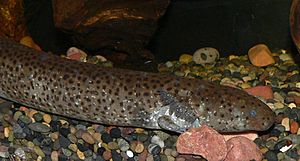Lesser siren facts for kids
Quick facts for kids Lesser siren |
|
|---|---|
 |
|
| Conservation status | |
| Scientific classification | |
| Genus: |
Siren
|
| Species: |
intermedia
|
The lesser siren (Siren intermedia) is a species of aquatic salamander native to the eastern United States and northern Mexico. They are referred to by numerous common names, including two-legged eel, dwarf siren, and mud eel. The specific epithet intermedia denotes their intermediate size, between the greater siren, Siren lacertina, and the dwarf sirens, Pseudobranchus species.
Behavior
The lesser siren is nocturnal, spending its days hidden in the debris and mud at the bottom of slow-moving bodies of water. They feed primarily on aquatic invertebrates, including various kinds of worms, insect larvae, snails, and crustaceans. They will also eat the tadpoles and eggs of other amphibians.
Reproduction occurs in the spring, with eggs being laid in shallow depressions at the bottom of calm areas of water, usually surrounded by vegetation, or among plant roots. Though little is known about their courtship, it is believed to be quite violent, as many specimens collected have scarring from healed bite marks from other sirens. About 12-300 eggs are laid at a time, and several clutches may be laid over the course of the year. Hatchlings are only about 0.4 in (1.1 cm) in length, but grow quickly. Maturity is reached in three to four years.
The lesser siren is vocal, unlike most salamanders, and will emit a series of clicks when it approaches others of its species, or a short screeching sound if handled.
If the habitat dries up during the summer, lesser sirens are known to endure droughts by burrowing into the mud. If the mud dries out, they are capable of excreting a substance from their skin which protects them from dehydrating, and enables them to stay buried in dry mud for months until the water returns. Their small legs enable them to move on dry land for short periods of time.
Description
Lesser sirens have elongated bodies possessing only two limbs, a pair of four-toed legs located behind the base of the head, and range in length from 7 to 27 inches (17 – 69 cm). Juvenile specimens have red to yellow banding on their heads and stripes running along the main length of the body, although these stripes are absent in Siren i. intermedia. Adults have plainer coloration; the dorsal side is typically olive green to blue-gray or black, while the ventral is usually light grey. Spotted patterns may also be present in adults.
Lesser sirens are notably neotenic, and possess external gills throughout their lives.
Geographic distribution
The lesser siren is found in the United States and Mexico, primarily from Virginia to Florida, west to Texas, ranging into northeastern Mexico as far as Veracruz, and north to Illinois and southwest Michigan. Multiple specimens have recently been rediscovered in Michigan after a 60-year absence.
Taxonomy
Sources disagree on the number of subspecies within S. intermedia; most agree there are at least two: an eastern and a western variety. Many sources also include a third subspecies, the Rio Grande lesser siren, S. i. texana, but researchers disagree whether the Rio Grande variety belongs as a lesser siren, within S. intermedia, or as a greater siren, within S. lacertina, and some others even consider it to be its own species, as S. texana.
- Eastern lesser siren, S. i. intermedia Goin, 1942
- Western lesser siren, S. i. nettingi Goin, 1942
- Rio Grande lesser siren, S. i. texana Goin, 1957
Conservation status
The lesser siren is quite common through most of its range, but rarely seen due to its secretive nature. Like almost all species of amphibian, their numbers are believed to be declining due to general reductions in water quality caused by agricultural pesticide and fertilizer runoff. They are frequently collected and used as bait for fishing.
The species was once believed to be extirpated from Michigan, but has been recently rediscovered in limited numbers. The S. i. texana subspecies is listed as a threatened species in Texas. They are listed as Least concern on the IUCN Red List and a species with "Special Protection" in Mexico.
See also
 In Spanish: Sirena menor para niños
In Spanish: Sirena menor para niños



